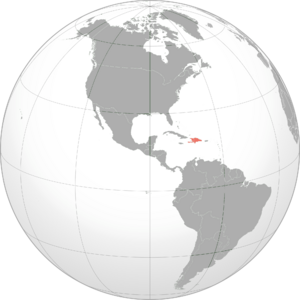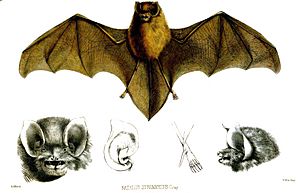Hispaniolan greater funnel-eared bat facts for kids
Quick facts for kids Hispaniolan greater funnel-eared bat |
|
|---|---|
| Conservation status | |
| Scientific classification | |
| Genus: |
Natalus
|
| Species: |
major
|
 |
|
The Hispaniolan greater funnel-eared bat (Natalus major) is a special type of funnel-eared bat. It lives only on the island of Hispaniola in the Caribbean. This island is home to both the Dominican Republic and Haiti. Scientists first described this bat in 1902. It mainly lives in caves and eats insects.
Contents
About Its Name and Family
Scientists first described the Hispaniolan greater funnel-eared bat in 1902. They named it Natalus major. Over the years, its family tree has been a bit tricky. For example, the Cuban greater funnel-eared bat (Natalus primus) was once thought to be a subspecies of N. major. But now, experts agree it's its own separate species. The same happened with the Jamaican funnel-eared bat (Natalus jamaicensis).
Scientists group these bats into a genus called Natalus. This group is known for a special bell-shaped organ on their forehead. It's called the natalid organ. The Hispaniolan greater funnel-eared bat is larger than others in its group. It also lives in a different area. Some scientists used to think this bat was the same as the Natalus stramineus, also known as the Mexican funnel-eared bat. However, newer studies show they are different species.
What It Looks Like
The Hispaniolan greater funnel-eared bat looks a lot like the Mexican funnel-eared bat (Natalus stramineus). The main difference is that the Hispaniolan bat is larger. When it was first described, the scientist didn't even give a detailed description. He just said it looked like a bigger version of the N. stramineus.
This bat's forearm is about 40 to 45 millimeters (1.6 to 1.8 inches) long. Its fur is soft and medium-long. It feels a bit like wool at the base. The fur on its back is a brownish-yellow color, like tawny-olive. Its belly fur is pink-buff. The membranes on its wings are a dark brown color, like umber. The large natalid organ on its forehead is shaped like a bell. Male and female bats look the same.
Where It Lives and What It Does
This bat is found all over the island of Hispaniola. This includes both the Dominican Republic and Haiti. While it has been reported in other places like Jamaica, those were actually different bat species.
Most of these bats live in caves. They need humid caves to rest during the day because their wing membranes are very delicate. Like all bats in its group, the Hispaniolan greater funnel-eared bat eats insects. It probably hunts for food in thick plants close to its cave home. Scientists don't know much about how these bats reproduce.
Protecting This Bat
The IUCN (International Union for Conservation of Nature) has listed the Hispaniolan greater funnel-eared bat as "Near Threatened". This means it could become endangered in the future. Even though it's found in many places, the caves it relies on are very fragile.
Some things that threaten these bats include:
- Tourists accidentally harming cave environments.
- Mining activities near caves.
- Taking guano (bat droppings) from caves, which can disturb the bats.
To help protect this species, the IUCN suggests that we simply "protect the caves" where they live.
See also
 In Spanish: Natalus major para niños
In Spanish: Natalus major para niños



